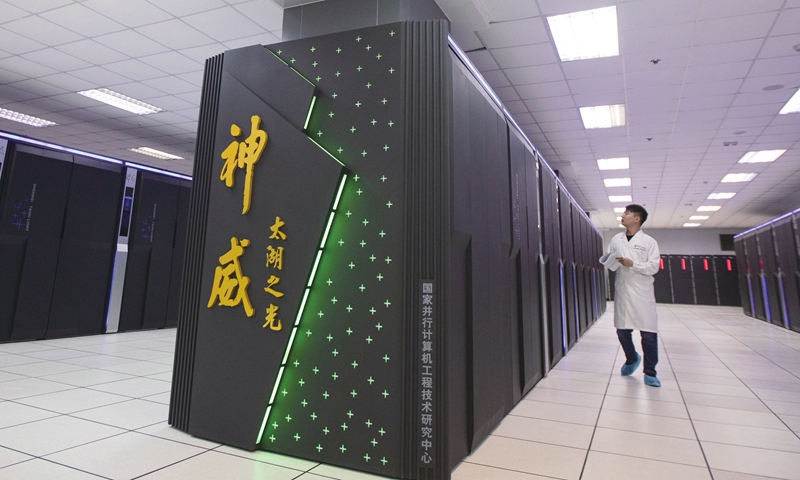
A scientist works at the National Supercomputing Center in Wuxi, East China's Jiangsu Province in August 2020. Photo: cnsphoto
Despite the US government's technology squeeze, Chinese scientists remain confident that the country's supercomputing industry will "get back on track" once the semiconductor manufacturing problem is addressed.
In the latest list of global Top-500 supercomputers, 186 Chinese supercomputers made to the list, accounting for nearly 40 percent of all on the list and making China the No.1 owner of the world's fastest supercomputers for an eighth time since November 2017.
However, the number has slightly dropped compared with the previous list. In the November 2020 Top-500 list, a total of 212 China-made supercomputers were included.
The Top-500 list was launched in 1993 and has continued to publish an updated list of the world's fastest supercomputers twice a year.
Sunway TaihuLight, a supercomputer developed by China's National Research Center of Parallel Computer Engineering & Technology, ranked the fourth in the latest list unveiled in June. The computer has a peak performance of 93 petaflops, which is a measurement of a quadrillion calculations per second based on the High-Performance Linpack benchmark. Its performance or ranking has not changed since the November 2020.
Tianhe-2A, a system developed by China's National University of Defense Technology and deployed at the National Supercomputer Center in Guangzhou, South China's Guangdong Province, came in No.7.
In comparison, the US is home to 123 of the world's fastest supercomputers, up from 113 computers from the previous list. Two supercomputers owned by IBM, the Summit and Sierra, rank second and third on the list.
Japan's Fugaku still held onto the top spot on the list with an HLP benchmark score of 442 petaflops, beating the Summit system by three times.
Supercomputers are massive computer machines which can be used for power-intensive programs such as quantum physics, forecasting the effects of global climate change, designing engines and aircraft or even reconstructing the history of the universe, overseas reports have noted.
US influence
Most experts who the Global Times has interviewed attributed the drop in Chinese representation to US technology crackdown on Chinese supercomputing companies, which they said had restricted advanced chip supplies to those facilities.
Zhang Yunquan, secretary general of the Technical Committee on High Performance Computing of the China Computer Federation, said that US government crackdown on Chinese companies would "certainly" generate a negative impact on the performance and growth speed of the sector in China.
"Considering the current situation, the gap displayed in the Top-500 list (Chinese-made supercomputer number) will likely increase in the second half of this year," he told the Global Times.
Ma Chao, technology industry analyst, told the Global Times on Friday that China's supercomputing development speed has slowed down under the US' technological squeeze, but as China has accumulated significant technological advantages in this field, the sector is likely to "get back on track" once the country achieves new breakthroughs in chip design and manufacturing.
"Whether in supercomputing or in other areas, the most fundamental issue is the chip supply. Once we surmount that mountain, the development space is vast," he said.
In April, the US Commerce Department added seven Chinese supercomputing entities to a US economic blacklist on the excuse that they are connected to military uses. The National Supercomputing Center Wuxi, which houses the aforementioned Sunway TianhuLight, is one of the seven entities.
Under the ban, those companies on the list must apply for licenses from the US government to gain access to import items from US suppliers. This is also seen as a method of the US' expanding crackdown on China's telecom sector, after the US blocked Chinese chip and mobile making giants Huawei Technology and SMIC.
But Xiang Ligang, director-general of the Beijing-based Information Consumption Alliance, said that some non-commercial associations in China might have been less willing to share their information and data of their supercomputers due to the current international environment, with concern over exposure to foreign sanctions or bans.
"Just because the data hasn't been made public there doesn't mean the supercomputers don't exist," he stressed.
Wider applications
The US' measures against Chinese supercomputing companies also reflected two countries' intensifying race in this sector, with the US developing its supercomputer industries much earlier but China catching up fast in recent years.
According to Zhang, the gap between China and the US still lies in the level of application and software industrialization.
"China used to place more emphasis on computing hardware than on software development, and there was not significant demand for supercomputing applications. The situation is now gradually improving," he said, adding that the industry is looking at enhancing its application level, particularly how to integrate and innovate on intelligent computing.
Experts also expressed optimism that supercomputing can be applied to more industries in China in the future.
"The general trend is that it will be first used in specific, professional sectors with larger budgets. But with reducing costs and increasing scale, smaller and private companies will also seek to use their services," telecom expert Fu Liang told the Global Times.
The key application areas of supercomputers in China mainly include weather forecasting, earthquake monitoring, transportation traffic planning, and environmental protection, he said.
Xiang also said that supercomputers will be gradually and widely adopted across all aspects of social life and work to improve urban services, such as monitoring and regulating urban transit systems.




